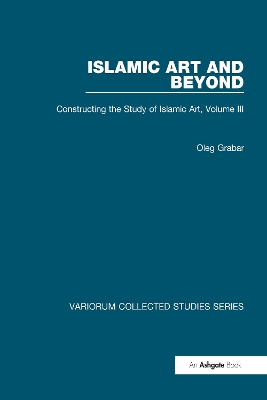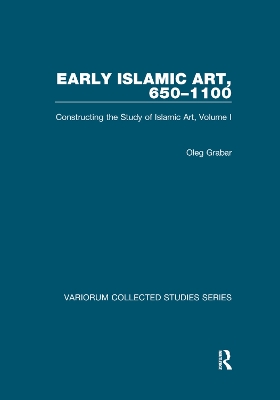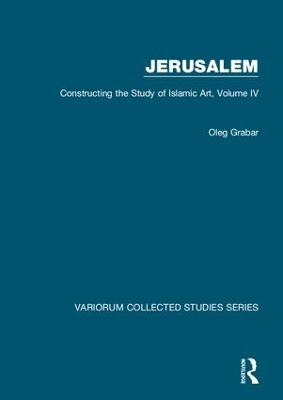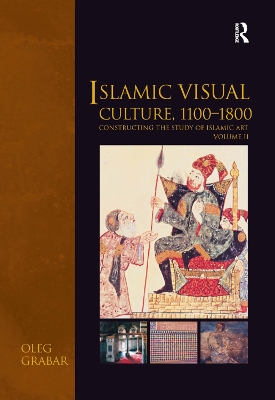Variorum Collected Studies
4 total works
Islamic Art and Beyond is the third in a set of four volumes of studies on Islamic art by Oleg Grabar. Between them they bring together more than eighty articles, studies and essays, work spanning half a century by a master of the field. Each volume takes a particular section of the topic, the three other volumes being entitled: Early Islamic Art, 650-1100; Islamic Visual Culture, 1100-1800; and Jerusalem. Reflecting the many incidents of a long academic life, they illustrate one scholar's attempt at making order and sense of 1400 years of artistic growth. They deal with architecture, painting, objects, iconography, theories of art, aesthetics and ornament, and they seek to integrate our knowledge of Islamic art with Islamic culture and history as well as with the global concerns of the History of Art. In addition to the articles selected, each volume contains an introduction which describes, often in highly personal ways, the context in which Grabar's scholarship developed and the people who directed and mentored his efforts. The articles in the present volume illustrate how the author's study of Islamic art led him in two directions for a further understanding of the arts. One is how to define Islamic art and what impulses provided it with its own peculiar forms and dynamics of growth. Was it a faith or a combination of social, historical, and cultural events? And how has 'Islamic art' impacted on the contemporary arts of the Islamic world? The other issue is that of the meanings to be given to forms like domes, so characteristic of Islamic art, or to terms like symbol, signs, or aesthetic values in the arts, especially when one considers the contemporary world. The Islamic examples allow for the development of new intellectual positions for the history and criticism of the arts everywhere.
Early Islamic Art, 650-1100 is the first in a set of four volumes of studies by Oleg Grabar. Between them they bring together more than eighty articles, studies and essays, work spanning half a century. Each volume takes a particular section of the topic, the three subsequent volumes being entitled: Islamic Visual Culture, 1100-1800; Islamic Art and Beyond; and Jerusalem. Reflecting the many incidents of a long academic life, they illustrate one scholar's attempt at making order and sense of 1400 years of artistic growth. They deal with architecture, painting, objects, iconography, theories of art, aesthetics and ornament, and they seek to integrate our knowledge of Islamic art with Islamic culture and history as well as with the global concerns of the History of Art. In addition to the articles selected, each volume contains an introduction which describes, often in highly personal ways, the context in which Grabar's scholarship developed and the people who directed and mentored his efforts. The present volume concentrates primarily on documents provided by archaeology understood in its widest sense, and including the study of texts with reference to monuments or to the contexts of these monuments. The articles included represent major contributions to the understanding of the formative centuries of Islamic art, focusing on the Umayyad (661-750) and Fatimid (969-1171) dynasties in Greater Syria and in Egypt, and on the Mediterranean or Iranian antecedents of early Islamic art. Historical, cultural, and religious themes, including the role of court ceremonies, the growth of cities, and the importance of the Qur'an, are introduced to help explain how a new art was formed in the central lands of the Near East and how its language can be retrieved from visual or written sources.
Jerusalem is the final volume in a set of four selections of studies on Islamic art by Oleg Grabar. Between them they bring together more than eighty articles, studies and essays, work spanning half a century by a master of the field. Each volume takes a particular section of the topic, the three others being entitled: Early Islamic Art 650-1100, Islamic Visual Culture, 1100-1800, and Islamic Art and Beyond. Reflecting the many incidents of a long academic life, they illustrate one scholar's attempt at making order and sense of 1400 years of artistic growth. They deal with architecture, painting, objects, iconography, theories of art, aesthetics and ornament, and they seek to integrate our knowledge of Islamic art with Islamic culture and history as well as with the global concerns of the History of Art. In addition to the articles selected, each volume contains an introduction which describes, often in highly personal ways, the context in which Grabar's scholarship developed and the people who directed and mentored his efforts. The focus of this volume is what is now known as the Old City of Jerusalem. This plays a unique role in Islamic culture, as a city whose physical shape was created by a succession of Muslim rulers on a base created by the Roman empire. And then Jerusalem shelters the Dome of the Rock, the first major building sponsored by a Muslim patron and one of the masterpieces of medieval architecture. Yet it is a building whose original purpose is still obscure. The articles selected for this volume represent nearly half a century of concern, by one of the world's foremost authorities on the subject, for this extraordinary city, for its buildings, and for the nexus of meanings associated with them.
Islamic Visual Culture, 1100-1800 is the second in a set of four volumes of studies on Islamic art by Oleg Grabar. Between them they bring together more than eighty articles, studies and essays, work spanning half a century by a master of the field. Each volume takes a particular section of the topic, the three other volumes being entitled: Early Islamic Art 650-1100; Islamic Art and Beyond; and Jerusalem. Reflecting the many incidents of a long academic life, they illustrate one scholar's attempt at making order and sense of 1400 years of artistic growth. They deal with architecture, painting, objects, iconography, theories of art, aesthetics and ornament, and they seek to integrate our knowledge of Islamic art with Islamic culture and history as well as with the global concerns of the History of Art. In addition to the articles selected, each volume contains an introduction which describes, often in highly personal ways, the context in which Grabar's scholarship developed and the people who directed and mentored his efforts. The focus of the present volume is on the key centuries - the eleventh through fourteenth - during which the main directions of traditional Islamic art were created and developed and for which classical approaches of the History of Art were adopted. Manuscript illustrations and the arts of objects dominate the selection of articles, but there are also forays into later times like Mughal India and into definitions of area and period styles, as with the Mamluks in Egypt and the Ottomans, or into parallels between Islamic and Christian medieval arts.



